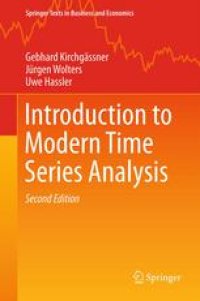
Ebook: Introduction to Modern Time Series Analysis
- Tags: Econometrics, Statistics for Business/Economics/Mathematical Finance/Insurance, Game Theory Economics Social and Behav. Sciences, Macroeconomics/Monetary Economics, Financial Economics
- Series: Springer Texts in Business and Economics
- Year: 2013
- Publisher: Springer-Verlag Berlin Heidelberg
- Edition: 2
- Language: English
- pdf
This book presents modern developments in time series econometrics that are applied to macroeconomic and financial time series, bridging the gap between methods and realistic applications. It presents the most important approaches to the analysis of time series, which may be stationary or nonstationary. Modelling and forecasting univariate time series is the starting point. For multiple stationary time series, Granger causality tests and vector autogressive models are presented. As the modelling of nonstationary uni- or multivariate time series is most important for real applied work, unit root and cointegration analysis as well as vector error correction models are a central topic. Tools for analysing nonstationary data are then transferred to the panel framework. Modelling the (multivariate) volatility of financial time series with autogressive conditional heteroskedastic models is also treated.
This book presents modern developments in time series econometrics that are applied to macroeconomic and financial time series, bridging the gap between methods and realistic applications. It presents the most important approaches to the analysis of time series, which may be stationary or nonstationary. Modelling and forecasting univariate time series is the starting point. For multiple stationary time series, Granger causality tests and vector autogressive models are presented. As the modelling of nonstationary uni- or multivariate time series is most important for real applied work, unit root and cointegration analysis as well as vector error correction models are a central topic. Tools for analysing nonstationary data are then transferred to the panel framework. Modelling the (multivariate) volatility of financial time series with autogressive conditional heteroskedastic models is also treated.
This book presents modern developments in time series econometrics that are applied to macroeconomic and financial time series, bridging the gap between methods and realistic applications. It presents the most important approaches to the analysis of time series, which may be stationary or nonstationary. Modelling and forecasting univariate time series is the starting point. For multiple stationary time series, Granger causality tests and vector autogressive models are presented. As the modelling of nonstationary uni- or multivariate time series is most important for real applied work, unit root and cointegration analysis as well as vector error correction models are a central topic. Tools for analysing nonstationary data are then transferred to the panel framework. Modelling the (multivariate) volatility of financial time series with autogressive conditional heteroskedastic models is also treated.
Content:
Front Matter....Pages i-xii
Introduction and Basics....Pages 1-25
Univariate Stationary Processes....Pages 27-93
Granger Causality....Pages 95-125
Vector Autoregressive Processes....Pages 127-154
Nonstationary Processes....Pages 155-203
Cointegration....Pages 205-249
Nonstationary Panel Data....Pages 251-279
Autoregressive Conditional Heteroscedasticity....Pages 281-310
Back Matter....Pages 311-319
This book presents modern developments in time series econometrics that are applied to macroeconomic and financial time series, bridging the gap between methods and realistic applications. It presents the most important approaches to the analysis of time series, which may be stationary or nonstationary. Modelling and forecasting univariate time series is the starting point. For multiple stationary time series, Granger causality tests and vector autogressive models are presented. As the modelling of nonstationary uni- or multivariate time series is most important for real applied work, unit root and cointegration analysis as well as vector error correction models are a central topic. Tools for analysing nonstationary data are then transferred to the panel framework. Modelling the (multivariate) volatility of financial time series with autogressive conditional heteroskedastic models is also treated.
Content:
Front Matter....Pages i-xii
Introduction and Basics....Pages 1-25
Univariate Stationary Processes....Pages 27-93
Granger Causality....Pages 95-125
Vector Autoregressive Processes....Pages 127-154
Nonstationary Processes....Pages 155-203
Cointegration....Pages 205-249
Nonstationary Panel Data....Pages 251-279
Autoregressive Conditional Heteroscedasticity....Pages 281-310
Back Matter....Pages 311-319
....